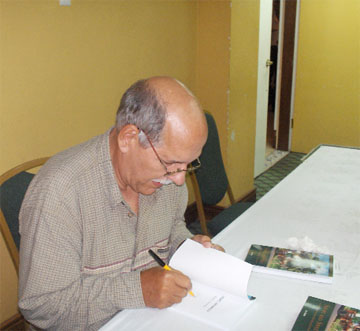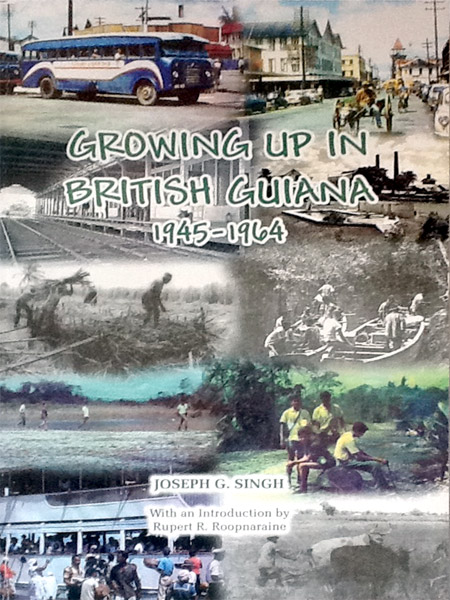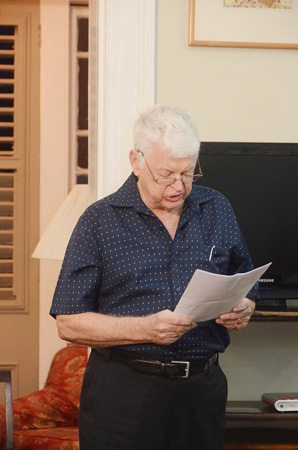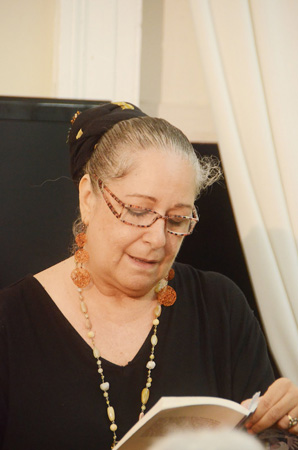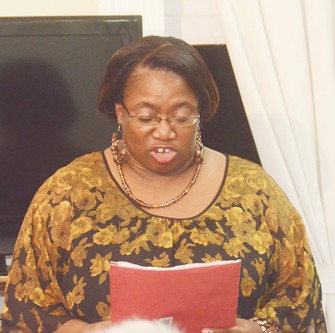Activity: Photographic presentation
Co-ordinator: Moray House Trust
Date: 17th February 2012 Continue reading ““Voice & Vision” by Bobby Fernandes”
The Moray House Trust and Martin Carter by Al Creighton
Source: Sunday Stabroek
Date: December 18th 2011
http://www.stabroeknews.com/2011/features/12/18/the-moray-house-trust-and-martin-carter/
“Two recent events brought Caribbean and Guyanese poet Martin Carter once again into focus. On December 13 a new cultural foundation, The Moray House Trust, was unveiled at Moray House, the de Caires residence in Georgetown, as a new venue for programmes and a promoter of activities in the arts and culture. The date of the launching was deliberately fixed since it was the fourteenth anniversary of the death of Carter, whose work and position as a major cultural icon and Guyana’s greatest poet the Trust wished to honour.
Two months before that, the 30th Annual West Indian Literature Conference was held at UWI St Augustine in Trinidad under the theme I Dream to Change the World: Literature and Social Transformation, taking its title from one of Carter’s many famous lines, “
Martin Carter
I do not sleep to dream, but dream to change the world” from the poem ‘Looking At Your Hands‘ (1950s). That is the foremost international conference on West Indian literature, and the Carter line easily allowed papers on social transformation and the literature of the Caribbean. Not only is the man often described as Guyana’s “National Poet” associated with social transformation in his many works, but the world has found his poetry to be very quotable, and there are several lines that have been quoted and sloganeered for diverse causes.
His work was featured in performances attached to the conference, and many past editions of the meeting have had papers read by various scholars on Carter. Very appropriately, the definitive book on Carter in which Stewart Brown collected and edited the major critical publications on him, was launched at the 20th meeting of this same Annual Conference at the University of Guyana in 2000. This authoritative text, All Are Involved: The Art of Martin Carter (Peepal Tree, 2000) took as its title one of those oft quoted Carter phrases from the poem ‘You Are Involved‘ (“all are involved / all are consumed”). Both literary and political interests have found this particular line very attractive because of its reference to popular involvement in a political or social process; the concept of belonging to a community and accepting responsibility for its fate. Involvement means commitment, and participation suggests belonging and inseparability from the outcome. The notion of ‘consumption’ is Carter’s characteristic concern for the inevitable. Brown attaches the line to the volume as a typical Carterian concept as well as the fact that several different critics have contributed and are therefore involved in the publication, as much as they are in the making and completion of Carter’s poetry.
This I have learnt:
today a speck
tomorrow a hero
hero or monster
you are consumed!
Like a jig
shakes the loom;
like a web
is spun the pattern
all are involved!
all are consumed!
Intertextual engagement with Carter has resulted in many other uses of his famous lines from which other titles have been framed because of this quotable quality and wide applicability. To all of those may be added the fact that the lines are striking poetic ways of expressing so many ideas relevant to human existence. They are profound, but also seem to speak for many political causes. Critic Gordon Rohlehr used ‘A Carrion Time‘ as his title in an article first published in Tapia (now known as Trinidad and Tobago Review) in the early 1970s as a response to the initial negative reaction to the rise of new unconventional and radical poetic forms in the Caribbean. Rohlehr turned to Carter again for the title of his collection of essays My Strangled City (Longman, 1992). The film by Rupert Roopnaraine, The Terror and the Time, was inspired by ‘The University of Hunger‘ (“the grave of pride / the sudden flight / the terror and the time”); and Grace Nichols looked to ‘Black Friday 1962‘ when naming her novel Whole of A Morning Sky (1986). Both novel and poem reflect on the violence and riots of 1962 in Georgetown which Carter expresses in one of his subtle uses of Creole syntax.
Was a day that had to come,
ever since the whole of a morning sky,
glowed red liker glory,
over the tops of houses.
Nichols draws on that haunting image of a “strangled city” on fire with its tragic scarlet reflection on the wide arch of the firmament painted in Carter’s grim lines. Endlessly have other lines been borrowed and repeated like proverbs: “but a mouth is always muzzled by the food it eats to live”; and “death must not find us thinking that we die” (from ‘Death of A Comrade‘).
The Moray House Trust is as much a dedication to the memory and work of David de Caires as its launching was dedicated to Martin Carter. de Caires probably loved the arts and culture more than law, and published, edited, read, studied and promoted poetry. Carter was among his chief comrades in arms, a poet whom he deeply admired, and together they were among the usual conspiratorial suspects in many years of poetry readings and literary discussions. Doreen de Caires, a trustee of Moray House, read from her husband’s notes which included a tribute to Carter. Actually, the notes contain the same material either published or orally presented by de Caires about the now legendary readings and discussions of poetry in sessions sanctified by the libations of gallons of Demerara’s finest rum. Both the spirit(s) and the quality of this rum have been famously confirmed by good authority. Such sessions must have been going on for many decades since Edgar Mittelholzer has immortalised them in poetry since the 1930s; and they continued in contemporary times since Stewart Brown has canonised them with similar immortality in Tourist, Traveler, Troublemaker (Peepal Tree, 2008).
Carter’s involvement in the discussions may be regarded as a part of his contribution to the national literary development. There is evidence that that kind of activity had its part to play and continued with the involvement of other poets – Donald Trotman, AJ Seymour, the PEN Club and Syble Douglas. The Irish, and indeed international, poet WB Yeats has been repeatedly mentioned as an inspiration to Carter and Wilson Harris, who was also a member of the discussion groups, and has written of the importance of Yeats to Carter. de Caires’ accounts have named him as Carter’s favourite poet and his ‘Among School Children‘ as, according to Carter, the best ever written. That claim is dubious, but it is not difficult to recognise the quality in Yeats that would have appealed to Carter, and this quality with its startling Yeatsian images and phrases is contained in the closing lines from the poem.
Labour is blossoming or dancing where
The body is not bruised to pleasure soul.
Nor beauty born out of its own despair,
Nor blear-eyed wisdom out of midnight oil.
O chestnut tree, great-rooted blossomer,
Are you the leaf, the blossom or the bole?
O body swayed to music, O brightening glance,
How can we know the dancer from the dance?
(WB Yeats, Among School Children)
This kind of spiritual involvement ponders the inseparability of leaf, blossom and tree, which define each other. The same interdependent symbiosis is transferred to the dancer’s body and the music; the dancer and the dance. The last line contains a pun: how can we tell the difference between the dancer and the dance; but also, how can we know anything about the dancer by looking at the dance? Carter’s poetry is much involved in this kind of integral questioning. The sentiments of the 60-year-old Yeats as he moves among the children recall Carter’s on his encounter with a 12-year-old girl on a road in rural Guyana in ‘The Poems Man,‘ a poem that has now become so very popular that Carter is known by the name.
Look, look, she cried, the poems man,
running across the frail bridge
of her innocence. Into what house
will she go? Into what guilt will
that bridge lead? I
the man she called out at
and she, hardly twelve
meet in the middle, she going
her way; I coming from mine:
The middle where we meet
is not the place to stop.
The poem contains something of Carter’s subtle use of the syntax of the Creole language in the girl’s use of “poems man” for “poet” and Carter’s own “I the man she called out at”; “I coming from mine” and “the place to stop,” which includes the Guyanese usage of “stop.” There is that proletarian quality in the poem, which includes the poet’s surprise at being recognised in these unlikely circumstances. But there is also the concerns which the poem shares with Yeats: the meeting of age and youth on a symbolic bridge with suggestions of distance, links, time and continuity.
The other Yeatsian connections include the work of both poets in national developments in their own times and places. Yeats was in sympathy with and had friends among the rebels in Ireland’s war for independence against the British in the first two decades of the twentieth century. He was also a statesman, serving as a Senator in the Irish government. Carter’s history in Guyanese politics is well known as a rebel imprisoned for his war against the British occupation in 1953, as a member of the PPP in the fifties, as a Minister in Burnham’s cabinet 1967-1970; his resignation from that post and his demonstrations against the PNC which led to him being beaten in the streets.
But an important part of that history is the contributions he made to cultural and political consciousness while working closely with Janet Jagan and his prose writings in Thunder. When he was later employed by Bookers, he secretly continued under the pseudonym ‘M Black.‘ In these writings may be found some of Carter’s profound thoughts on culture and nationhood, two short stories and (separately) his contemplations on poetry, form and metaphysics in the group Poems of Shape and Motion (1955).
His contribution to nation-building is deep and varied in public, private and artistic capacities. It has often been said that a poet of this depth and quality should have had wider international acclaim, and for several years his books were out of print and access to his work limited. Included in the tributes paid to him since is the way this work has been several times reprinted and spread abroad. Among these re-publications have been Selected Poems (1989) by Demerara Publishers, reprinted by Red Thread in 1997; collections edited and republished by the University of Warwick with Spanish translations, edited by Gemma Robinson and published by Bloodaxe; with yet another edition by Stewart Brown and Ian McDonald, published by Macmillan Caribbean in 2006.”
At launch of Moray House Trust: “we want young people to colonise the space here”
Source: Guyana Chronicle
Date: December 17 2011
The Moray House Trust was launched at the de Caires family home at Lot 239 Quamina and Camp streets, South Cummingsburg, Georgetown on Tuesday. It represented a signal tribute to the legacy of the late Attorney-at-law Mr. David de Caires, founder of the independent Stabroek News newspaper.
The commemorative launch formed the highlight of a three-tier programme which also accommodated the 14th Anniversary commemoration of the life of Guyana’s celebrated national poet, Martin Carter, and the launch of a book, “Growing up in British Guiana: 1945-1964”, written by retired Major General Joseph Singh.
Evening of elegance
Organized by the de Caires family and Trustees and Board of Directors of the Moray House Trust (MHT), the programme was literally an evening of elegance chaired by former Trustee Dr. Yesu Persaud.
Things got underway with opening remarks by widow Mrs. Doreen de Caires and a tribute to David de Caires by his daughter Isabelle. Reflecting on the life and work of the great cultural icon, Mrs. De Caires noted: “Our society has been greatly enriched by his (David’s) work.”
Although better known for his role in founding the independent Stabroek News publication, the Directors noted that Mr. de Caires had a strong and abiding interest in literature, the arts, music and sport.
“His contribution to the cultural life of Guyana, though modest, was symptomatic of his belief in the need to nurture the cultural and intellectual life of a nation in danger of losing its most precious resource – its people – through mass migration,” they said, adding, “His family and friends now pay tribute to him by forming this Trust.
Visionary work
The main work of the Moray House Trust is to provide sanctuary for cultural and artistic expressions, and the exchange of knowledge and ideas. And in broad outline, it is a private, non-partisan, non-profit cultural initiative designed to foster national pride in Guyana’s diverse heritage; to enable all forms of artistic expression; to promote conservation, civil liberties and sport in the Guyanese society; and to stimulate the sharing of knowledge and ideas within a vibrant sphere.
The vision of the Moray House Trust, among other things, is to: Preserve and extend Guyana’s cultural heritage, and to promote more opportunities for current and future generations to engage with it.
At the ceremony, the Moray House Trust Logo/Plaque was unveiled by the de Caires family, after which a bouquet of flowers was presented to Ms. Vanda Radik, Chairwoman of the Board of Directors of Moray House Trust. Other Members of the Board are: Dr. Paloma Mohamed, Colin Cholmondeley, Nadia Sagar, Clinton Urling, Nisa Surujbally and Mrs. Cathy Hughes.
Trustees are: Mrs. Doreen de Caires, Isabelle de Caires, Dr. Yesu Persaud, Major General (R’td) Joe Singh, and Andaiye.
The facilities at MHT are available for events, including: cocktail parties, lunches and dinners, tea parties and other social functions; business meetings; workshops, training presentations and lectures; youth groups and student meetings. “We want young people to colonize the space here,” Ms. Radzik commented.
Celebrating Martin Carter
This segment was chaired by Ms. Vanda Razdik. Hosted under the theme “Celebrating the Power and relevance of Martin Carter’s work for all seasons and generations”, it opened with Dr. Ian Mc Donald’s tribute to Martin Carter in which he noted that it was very appropriate that the launch featured the venerated poet, especially since those two gentlemen had a very close connection. Dr. Mc Donald also congratulated the de Caires family for initiating the idea of the Moray House Trust, and those who worked to bring it to fruition.
There were also choice poetic presentations by promising Guyanese youths, including: Maryam Bacchus of Queen’s College, who did one of Martin Carter’s pieces, “Not I with this Torn Shirt”; Kojo Mc Pherson; Rochelle Christie; Tivia Collins; Kencil Banwarie; Chontelle Sewette, and Jamilia Whittaker; and a video presentation, “Looking at Your Hands”, by Dr. Paloma Mohamed.
Introducing a new book
The curtain came down with the introduction of Major General (R’td) Joseph Singh’s book “Growing Up in British Guiana: 1945-1964”. The book captures the varied and exciting experiences of the author growing up as a child in British Guiana. Introduced by Dr. Rupert Roopnaraine, who hailed it as a labour of love, the book is the most recent of five publications by Mr. Joe Singh, whom Dr. Roopnaraine acknowledged for his many sterling contributions to the nation.
The retired Major General read a few spirited and animated passages from the book, and concluded, “This is a way of telling my grandchildren where they came from.”
The book is currently on sale at Austin’s Book Store on Church Street, Company Path, Georgetown at a cost of $1500.
De Caires “Moray House Trust” open for public functions
Source: Guyana Times
Date: 14th December 2011
The Moray House Trust set up in memory of the late David de Caires was declared open on Tuesday. It will be based at Moray House, the de Caires family home and one of the oldest houses in Georgetown. The Moray House is a traditional wooden “heritage” house located at 239 Camp and Quamina Streets.
Doreen de Caires at the launch read two pieces written by her husband, in which he recollected on the late Martin Carter and Ian McDonald. She reflected on his work, not only as a journalist, but his love for literature and poetry. De Caires’ daughter, Isabelle, in remarks at the launch, spoke about her father’s passion for literature.
Yesu Persaud, a trustee of the Moray Trust, thanked the de Caries for their move to open up their home to the public, to allow youth a greater chance of developing love for literature, arts, culture, and poetry. Persaud reflected on the work of David de Caires and his contributions to Guyana in many areas. Tribute was also paid to Carter during the opening ceremony.
Retired Major General Joe Singh also took the opportunity to launch his fifth book, “Growing Up in British Guiana: 1945-1964”. The book’s introduction was written by Dr Rupert Roopnaraine. Singh read several excerpts to give the gathering a taste of what they can expect from the book.
The new trust aims to work towards preserving and extending Guyana’s cultural heritage and to provide more opportunities for current and future generations to engage in such. The trust was also established to broaden local culture and enable youth to become innovators and champions of culture of all forms. Organised cultural events, public talks, debates, exhibitions, and workshops can be held at Moray House.
It was disclosed that although David de Caires was better known for his role in founding the Stabroek News in 1986, with the help of Ken Gordon, he also had a strong interest in literature, the arts, music, and sport. His family is, therefore, paying tribute to him by forming the trust.
David de Caires, who was born on December 31, 1937, was a Guyanese solicitor and later Editor-in-Chief of Stabroek News. He founded the Stabroek News because he wanted a paper that promoted an open society based on the rule of law, a free market economy and the holding of free and fair elections.
He suffered a heart attack on August 14, 2008 and underwent medical treatment in Guyana, and Trinidad and Tobago. He was later transported to a hospital in Barbados where he died on the morning of November 1, 2008. He is survived by his widow Doreen, son Brendan, and daughter Isabelle.
Cultural trust launched in memory of David de Caires,
Source: Stabroek News
Date: Wednesday 14th December 2011
“In an initiative aimed at helping to preserve and expand Guyana’s cultural heritage, the Moray House Trust was last evening officially launched in memory of late Stabroek News Editor-in-Chief David de Caires.
The Trust was launched at the de Caires’ family home, where Major General (ret’d) Joe Singh also launched his latest book, ‘Growing up in British Guiana: 1945-1964.’
The Trust is a private, non-profit cultural initiative aimed at fostering national pride in Guyana’s diverse heritage, and to enable all forms of artistic expression.
It is also aimed at promoting conservation, civil liberties and sport in society while stimulating the sharing of knowledge and ideas within a vibrant public sphere.
Isabelle de Caires, daughter of David de Caires, said that the Trust was being established in honour of her father, who, she said, not only had a deep interest in the arts and culture but also in encouraging discussion and debate on these matters. She noted that for several years, her father had opened his home to his friends and they would be engaged in wide-ranging discussions of an intellectual nature. de Caires died in November 2008.
The trust aims to achieve its mission through a variety of activities, including organizing public cultural events such as talks, debates, exhibitions and film shows. Further, it plans to support and facilitate live local cultural entertainment in areas such as dance, music and storytelling as well as to produce “cultural products” such as books, DVDs and recordings. Another aim of the Trust is to bring creative artists together with peers, experts and an informed audience to advance local talent.
Promoting hobbies and pastimes such as reading and music appreciation and cultural interests through its cultural programme and workshops are also part of the Trust’s agenda.
The trustees of the organization are Andaiye (Chairman), Doreen de Caires, Isabelle de Caires, Yesu Persaud and Singh. Vanda Radzik chairs the Board of Directors. Other directors are Colin Cholmondeley, Dr Paloma Mohamed, Nadia Sagar, Nisa Surujbally and Clinton Urling.
Singh, meanwhile, launched his fifth publication and read excerpts. The text chronicles Singh’s life from childhood to an adolescent. Dr Rupert Roopnaraine, long-time friend of the author, indicated that while Singh had a lot of accomplishments, this book was not the least of his contributions to the nation.
Yesterday’s launch was also a tribute to the work of the late poet Martin Carter, who died 14 years ago. Dr Ian McDonald paid tribute to Carter and several of Carter’s more popular poems were read.”
Launching of the Moray House Trust
Activity: Poetry Reading, Book Launch, Formal Launch of Moray House Trust
Co-ordinator: Moray House Trust
Date: Tuesday, 13th December 2011 Continue reading “Launching of the Moray House Trust”
Tomorrow and the World
Title: “Tomorrow and the World”
Item: Poem
Reader: Ian Mc Donald
Date: 13th December 2011
You Tube Link: http://www.youtube.com/watch?v=upFUTNTZRfg Continue reading “Tomorrow and the World”
Three Poems of Shape and Motion: No. 1
Title: “Three Poems of Shape and Motion: No. 1”
Item: Poem
Reader: Vanda Radzik
Date: 13th December 2011
You Tube Link: http://www.youtube.com/watch?v=Ug8EeGWd22c Continue reading “Three Poems of Shape and Motion: No. 1”
This is the Dark Time my love
Title: “This is the Dark Time my love.”
Item: Poem
Reader: Rochelle Christie
Date: 13th December 2011
You Tube Link: http://www.youtube.com/watch?v=ehVIJ-gA3wI Continue reading “This is the Dark Time my love”

